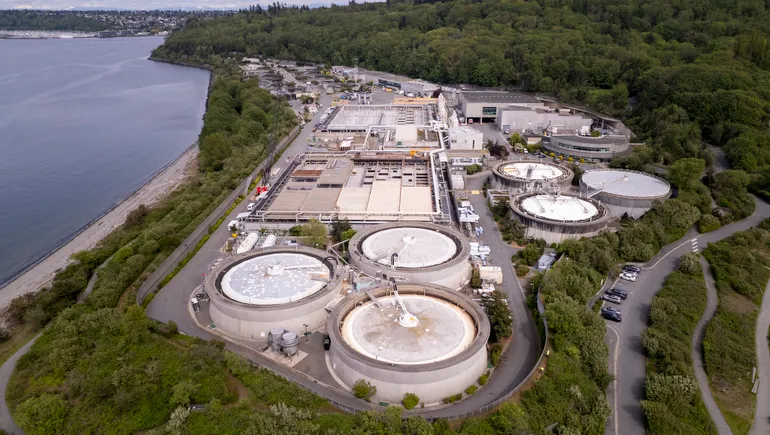Seattle area investing $10B in wastewater infrastructure

An article from

Dive Brief
King County, Washington, is planning a slew of resilience and clean water upgrades over the next decade, bolstered by new EPA loan financing.

Seattle’s King County West Point Treatment plant is seen in 2022. The county plans to invest $10 billion in wastewater treatment and other resilience measures in the coming decade.
Retrieved from King County Wastewater Treatment Division on April 11, 2024
This audio is auto-generated. Please let us know if you have feedback.
Dive Brief:
- Washington’s King County plans to invest $10 billion in wastewater treatment and other resilience measures in the coming decade in order to reduce pollution in waterways and prepare for storms, which are likely to become more frequent and intense due to climate change.
- The Wastewater Treatment Division’s plans got a huge boost on March 28 when the EPA announced a $194 million loan to support critical wastewater infrastructure updates. It’s the first installment of a nearly $500 million low-interest loan package that aims to make the system more reliable and protect Puget Sound.
- The new funding will help replace raw sewage pumps and provide seismic upgrades for the administration building at Seattle’s West Point Treatment Plant. The facility treats millions of gallons of wastewater each day and receives sewage and stormwater flows from Seattle, Shoreline, North Lake Washington, northern areas of King County and southern parts of Snohomish County, according to the Seattle Times.
Dive Insight:
The $500 million loan package is expected to help the county complete 14 critical infrastructure upgrades including seismic updates at two regional wastewater treatment plants, improvements to the recycled water system and upgrades to miles of conveyance and sewer pipes.
These 14 project include:
- Eastside Interceptor Section 8 Rehabilitation: Repairs one of the largest conveyance pipes in the system in Bellevue that is nearing the end of its service life.
- Lake Hills and Northwest Lake Sammamish Interceptor Upgrade: Installs 4.5 miles of sewer pipe serving Redmond and Bellevue.
- Sammamish Plateau Diversion: Adds capacity to treat wastewater flow from East Lake Sammamish area.
- West Point Treatment Plant Primary Raw Sewage Pump Replacement: replaces the original raw sewage pump system and makes seismic upgrades to the pump building at the plant, located in the Magnolia neighborhood of Seattle.
- South Treatment Plant Influent Pump Station Seismic Upgrades: Protects the Renton-based plant from large seismic events.
The loan funding comes from the 2014 federal Water Infrastructure Finance and Innovation Act, which aims to accelerate investment by providing long-term, low-cost credit assistance for regionally and nationally significant projects. King County’s Wastewater Treatment Division was the first entity to receive a WIFIA loan in 2018.
“EPA’s WIFIA loans have a track record of success and nowhere is that clearer than here in King County, where two loans have already reduced the amounts of sewage and untreated stormwater entering local waterways,” said EPA Acting Assistant Administrator for Water Bruno Pigott in the release.
Bolstering wastewater infrastructure
The King County Wastewater Treatment Division has advanced dozens of capital projects over the past five years. Before remediation work began on the West Point plant, about 30 billion gallons of combined sewage and stormwater would overflow into Puget Sound every year, according to the Seattle Times; it’s now about 1 billion gallons.
In addition, several system failures during a 2017 storm caused significant flooding at the facility and resulted in an estimated 244 million gallons of untreated or partially treated sewage discharging into the Sound. That pollution degrades water quality and impacts marine animals and the people who rely on them for subsistence and commercial fishing.
Water infrastructure is a booming business around the country. From massive stormwater tunnels, like Washington, D.C.’s $2.7 billion in-progress system; to levees, surge barriers and tide gates such as those underway in Norfolk, Virginia; to PFAS remediation, major contractors including AECOM, Flatiron, Jacobs and WSP are increasingly emphasizing water work.
The sector has also gotten a lift from the federal Infrastructure Investment and Jobs Act, which contains $50 billion for the EPA to improve drinking water, wastewater and stormwater infrastructure. It marks the federal government’s single largest investment in water.




